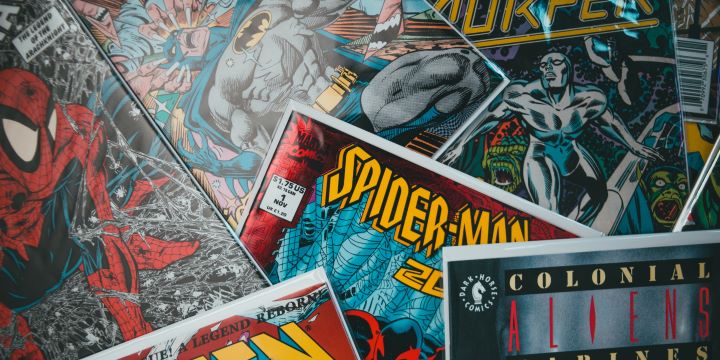Key Takeaways:
- Analysis of the digital transformation in comic book creation
- Discussion on how digital art software influences comic book artistry
- Insight into independent creators’ adaptation to digital publishing
- Exploration of the balance between artistry and technology
- Consideration of the environmental impact of digital comics vs. print
Table of Contents:
- Introduction to Comic Books and the Digital Shift
- Transition to Digital: How Creators are Adapting
- Trends in Digital Comic Book Consumption
- The Benefits of Digital Production for Independent Creators
- Tools of the Trade: Software and Hardware for Digital Creators
- Balancing Art and Technology: Maintaining Artistic Integrity
- Environmental Impact: The Green Advantage of Digital Comics
- The Role of Social Media in Marketing Digital Comics
- The Future of Comic Books: Predictions and Potential
- Embracing Change in the Comic Book Industry
Introduction to Comic Books and the Digital Shift
Comic books have shaped the roots of popular culture with their vivid visuals and compelling narratives. Traditionally print-based, this narrative art form is undergoing a significant transformation catalyzed by the digital revolution. With the advancement of digital platforms, artists now have the option to use services for comic book printing, which effectively caters to the thriving digital audience and traditionalists who savor the tactile feel of paper. This pivotal shift is a watershed moment, offering new modes of creation, distribution, and access to comic book content, and stands to impact the industry in ways we’ve only begun to comprehend.
The adaption to digital media has changed how comic books are consumed and revolutionized the processes behind their creation. Modern-day cartoonists often wield styluses instead of pens, sprawling their art across screens with a precision once confined to the pages of time-honored journals. Their art is no longer hemmed by the constraints of the physical world but liberated by the boundless potentials of the digital landscape.
Transition to Digital: How Creators are Adapting
The leap from paper to pixel has proven influential for comic book creators. Digital art software has leveled up the process of illustrating, coloring, and lettering, bringing to life frames more swiftly and with greater editing flexibility than ever before. Artists are deftly adapting by mastering the nuances of digital art platforms, rendering their visions with a freshness and vibrancy that resonates with contemporary audiences. Meanwhile, publishers and platforms are quickly adapting to this rapidly growing medium, providing viewers access to a wide range of webcomics, downloadable issues, and even serialized digital stories directly to their devices.
Trends in Digital Comic Book Consumption
In recent years, there’s been a discernible pivot towards digital consumption of comic books. Convenience plays a pivotal role as readers abandon lengthy queues at the local comic store for instant access through their smartphones, tablets, and PCs. It’s a trend that isn’t just anecdotal; sales figures underscore a steady uptick in digital comic book revenues, suggesting a cultural shift towards the medium.
The Benefits of Digital Production for Independent Creators
For the individual artist or small press, the digital age has unlocked doors that were once firmly shut, presenting a frontier of opportunity free from the rigors and expenses of traditional print production. The rise of digital comic book creation and its ancillary distribution channels has leveled the playing field for independent creators. With reduced overhead costs and the ability to self-publish online, these artists can reach a broader audience than ever before. They can knead the dough of their dreams into tangible constructs with just a fraction of the previous barrier to entry.
Tools of the Trade: Software and Hardware for Digital Creators
The digital artist’s toolkit is filled with innovative software applications and devices that streamline creation. Observed within the ecosystem of comic book design are robust programs like Adobe Photoshop and Illustrator, as well as industry-specific tools like Clip Studio Paint, designed with the comic artist’s needs in mind. Meanwhile, drawing tablets from companies such as Wacom provide an intuitive interface for artists who value the traditional hand-drawn approach but seek the benefits of digital manipulation. These tools have not only revolutionized how artists create but also offer an unprecedented level of efficiency and creative control.
Balancing Art and Technology: Maintaining Artistic Integrity
While the arsenal of digital tools provides comic creators with an expanded palette of options, the heart of comic book artistry remains rooted in the creators’ storytelling and drawing skills. Even the most advanced technology serves as a complement to the narrative, not a replacement. Embracing tablets and software serves to amplify an artist’s creative voice, not override it. Shrewd creators are frequently seen blending the old with the new, scanning hand-drawn sketches to be embellished with digital textures and colors, thus ensuring their art retains the warmth of its analog origins while indulging in the precision of digital craftsmanship.
Environmental Impact: The Green Advantage of Digital Comics
Amid the growing environmental sustainability consciousness, digital comics offer an eco-friendly alternative to paper-based publications. According to in-depth research, digital publications can boast a smaller carbon footprint when compared to their print counterparts. The transition to digital media helps mitigate the industry’s environmental impact by reducing paper production, ink usage, and the physical distribution that collectively contributes to a heavier carbon load.
The Role of Social Media in Marketing Digital Comics
Social media has emerged as a fertile ground for marketing digital comics in today’s hyperconnected world. Platforms such as Twitter, Instagram, and Facebook are not only launching pads for comic book campaigns, but they also forge real-time connections between creators and their fan base. Social media provides an intimate space where artists can share their creative process, tease upcoming releases, and directly engage with the audience in meaningful dialogue. It’s a dynamic environment that can turn a nascent comic series into a cultural phenomenon virtually overnight.
The Future of Comic Books: Predictions and Potential
The pages of the future for comic books are unwritten and abundant with potential. Technological advancements hint at a new era characterized by more interactive digital storytelling, potentially integrating elements like animations, voiceovers, and virtual reality to create an immersive reading environment. Storytellers are poised to experiment with these new forms, meshing traditional narrative techniques with groundbreaking tech to define the next chapter of comic book evolution.
Embracing Change in the Comic Book Industry
As we reflect on the strides made within the comic book realm, we observe a canvas that has evolved and expanded, inviting storytellers and readers alike to explore new horizons. The future of comics is not merely an extension of its past but a reinvention propelled by the digital age. With each passing day, the line between the artist’s studio and the reader’s screen blurs a little more, heralding a future where comic books continue to captivate the imagination in ways once thought unimaginable. The embrace of this change will ensure that the soul of the comic book ( its power to reveal our heroes, fears, and dreams ) will endure for generations to come.





